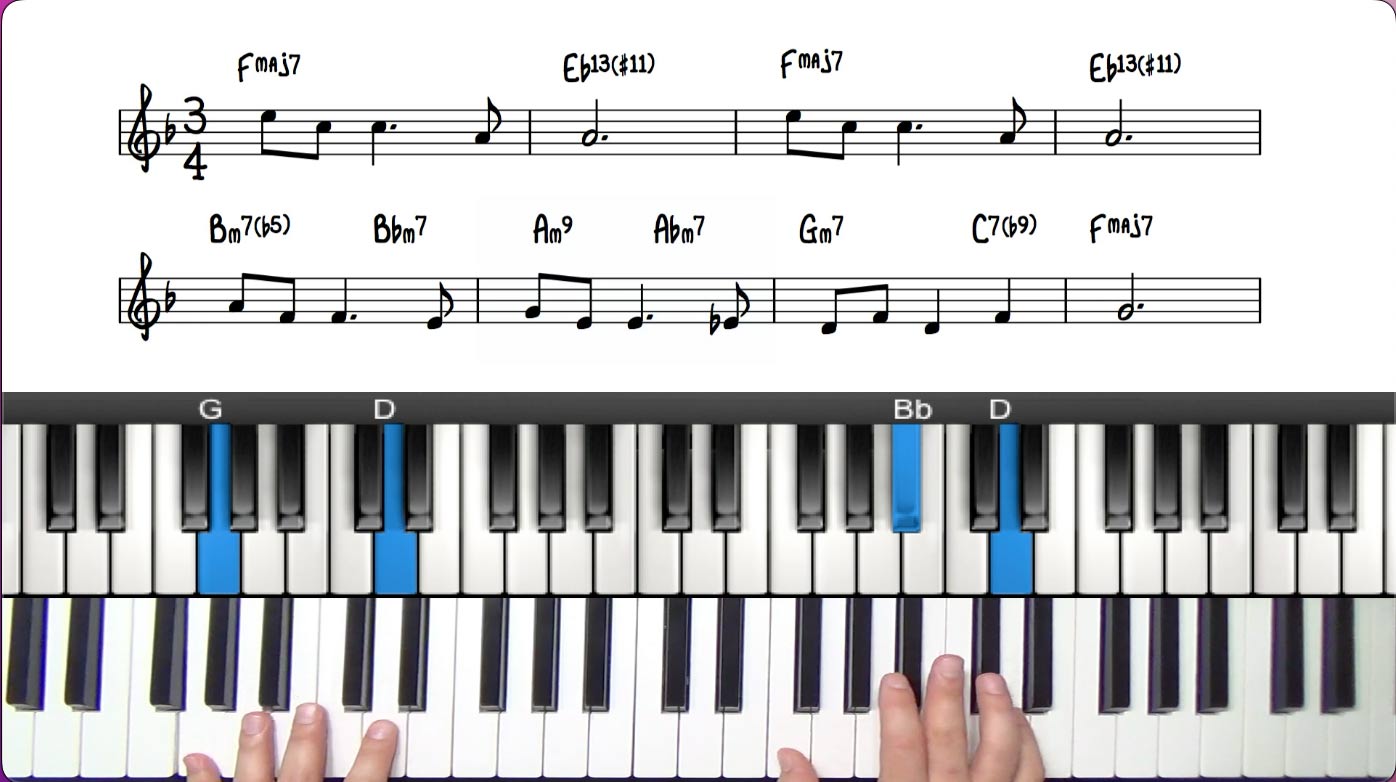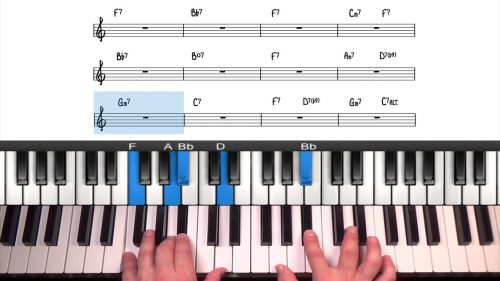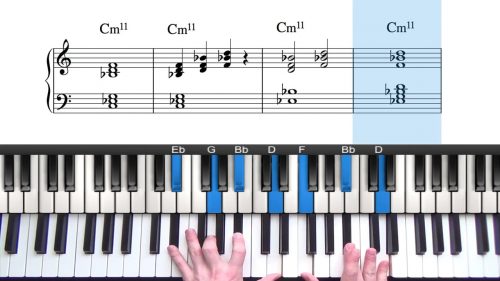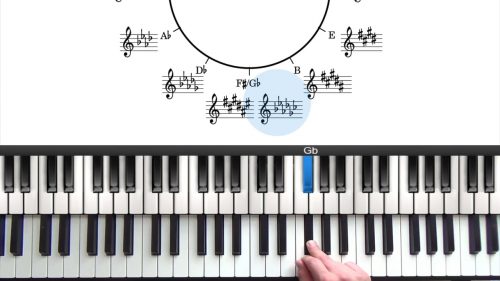Christmas Time Is Here Tutorial
In this lesson we will be creating a jazzy Christmas arrangement for the tune ‘Christmas Time Is Here’.
The tune is written in ¾ and has a laid back tempo which can be interpreted freely.
We jump straight in with two-handed voicings, initially starting with simpler chords and then gradually increasing the complexity of the voicings we choose to play.
As well as a full arrangement we will also be exploring some ideas and concepts for soloing over the form of the tune. In particular we will look at:
-
Creating and developing musical motifs
-
Using chord tones in improvised lines and phrases
-
Identifying and focusing on the ‘characteristic’ tones of the chord/mode
Practice Tips
-
Try to familiarise yourself with the distinctive sound of the #11 over the Eb7 chord.
-
Play the melody in the upper registers and arpeggiate your left hand voicings.
-
Listen to lots of recordings of the tune for more inspiration.








Hayden, I have a question as to why the Eb13(#11) in the second measure uses #11 and not (b5) and in the fifth measure, the Bm7(b5), which is a scale of all sharps, uses the b5 and not #11 to indicate the note? I’m probably more used to seeing Bm7(b5) because of the term “minor7b5” designation used for the 7th jazz chord; but why isn’t the Eb13(b5) used since it is a scale with flats?
Hi Lonnie,
Good question.
Firstly understand that there is no standardised way to refer to alterations. The most contentious example is the #5 or b13. Enharmonically it is the same note but you will find different jazz musicians refer to it differently. I have always favoured the #5, but in some lessons I do also use b13 and then explain that you will come across both terms, just so that students are aware of this.
Now onto your question…
The key thing you should analyse is the tonality of the chord you are dealing with ie. is it major, minor or dominant? The key signature is irrelevant in terms of analysing the alterations.
Here’s the rules I follow:
Rule 1) For major and dominant chords, it would always be the #11 and not the b5.
The associated chord scale for Eb13#11 would be the Lydian Dominant mode. The notes are Eb(root), F(9), G(3), A(#11), Bb (5), C(13) and Db(b7). Notice that the natural 5 (Bb) is in there – therefore the A must be the #11. Otherwise how would you analyse.classify the Bb?
You can apply the same analysis to major chords, because the natural 5th is present in the Lydian mode.
Rule 2) For -b75 and dim7 chords, it would always be the b5 and not the #11.
For -7b5 chords, it is specified in the chord symbol that the b5 should be present. But if you wanted to analyse it further….
The associated chord scale for B-7b5 would the B Locrian (from major scale harmony) or B Locrian natural 2 (from melodic minor harmony)
The notes would be B(root), C or C# (b2 or 2), D (b3), E(4 or 11), F(b5), G(b6) and A(b7). Notice that the 4 or 11 (E) is present in the scale, therefore the F must be the b5.
Does this kind of analysis make sense?
My recommendation Lonnie would be to always analyse the chord and corresponding scale numerically. This will help you identify each tone from a numeric, or functional standpoint. I hope this helps… if you’d like any further explanation let me know :-)
Cheers, Hayden
Great lesson. You show opptunities but still you are not going to far away from the trancription. Wonderful
Brilliant, I’m glad you enjoyed it Jimmy.
I see you’re getting a head start on this year’s Christmas songs 😄
Cheers and enjoy the lessons!
Hayden
Amaj7 in the sheet music should be A minor 7?
Hayden
This video is not loading for some reason
K
for some reason each time I play video its echoing thru my headphone
Hi Odell,
Thanks for letting me know about this.
Is this just happening with your headphones or with the regular speakers on your device?
I have asked our tech guys to investigate this.
Cheers,
Hayden
There is no pdf of chord changes?
Hi @Humberto, See the comments I gave to @Noreen below your questions for the answers. Cheers. Armando
thanks so much Armando
Hi Humberto, apologies for the late reply here.
For some reason the chord chart and transcription were missing, please now see the “Downloads” section where these files are listed.
Cheers,
Hayden
Hayden. thank you
Hi Hayden,
Ron T here . Is there pdf for this song, Long time student but battling some health issue. Love this site.
Best Regards,
Ron
Hi Ron,
Yes please see the downloads section, for some reason these PDF files disappeared but I have added them back again.
Enjoy the lesson!
Cheers,
Hayden
Is there a transcription for Christmas Time is Here? That’s such a great little song. I can’t find it. If you have one, please upload it so the rest of us can enjoy it.
I love your Christmas arrangements.
Thanks so much!
Hi Noreen.
Yes I have just added the PDF downloads, apologies I’m unsure why these were missing from this page.
I’m glad to hear you like the Christmas arrangements, i just published some new lessons on the tune “Jingle Bells”, you can find those lessons here:
pianogroove.com/jazz-piano-lessons/christmas-song-improvisation/
More lessons will be added into this new course shortly.
Cheers,
Hayden
Hi @Noreen, It’s all there (i.e. the sheet music, the lead sheet, the video and more). Look at pianogroove.com/jazz-piano-lessons/jazzy-christmas-songs/ , then “Jazzy Christmas Course Lessons, ” has the video. For the PDFs and sheet music, go to the URL I gave you as a link…go past the Course Lessons, then past the Course Info and all the pdfs are at the bottom of the page. It is a gorgeous song, but I found I had a lot of work to do on the fingering Hayden used (which I put on the lead sheet and the improvisation on separate staff sheets) . The pretty beginning is part of the sheet music, not the lead sheet, and one can play around with the improv. I’m still trying to get it to be smooth and the work on feeling! But what a great goal to shoot for (I’m between a beginner and an intermediate (if there is a word for that level)). It is beautiful.
Hi Armando,
Thanks so much for helping Noreen find the PDF files. For some reason they were missing from this page but I have now added them back in.
You might also like to check out my new Xmas lessons here: pianogroove.com/jazz-piano-lessons/jazzy-christmas-songs-part-2/
Cheers,
Hayden
Hi Hayden,
My pleasure. I’m not sure how helpful it was because it looks like a broken links issue. But I tried… Thank you for the Christmas songs. I do love the arrangements and working on them. I’m slow but consistent :-)
Merry Christmas (2022) to all! ❄️❅❅❆❆❅❅❄️
Hayden, I find your arrangements (and especially the explanations) very helpful. But I notice that the arrangements here are limited in terms of the keys. I have tried to expand my harmonic vocabulary by transposing the arrangements into different keys. So, for example, if the song is in C, I try to play it in Bb and Eb as well.
Progress is slow and sometimes quite frustrating, but I find that I can do it eventually. It just means that I progress very slowly from one song to another.
Do you think this approach is helpful? Or should I just limit myself to learning the songs in the keys that you have given?
Bruce.
Hi Bruce,
Thanks for getting in touch and I’m glad you are enjoying the lessons.
Whether it’s best to learn new tunes or transpose the ones you already know, this depends on your personal goals and objectives with jazz piano. Transposing songs will give you a deeper and more thorough understanding of the tunes that you already know, and learning new songs will expand your repertoire and expose you to new harmonic situations.
Both approaches have merit. If you are currently happy with the size of your repertoire then by all means transpose the songs that you already know, or if you want to expand your repertoire, you can pick a handful of new tunes to work on.
When playing jazz music, the keys of C, F, Bb, Eb are the most common keys for jazz standards and so it’s normal to be more familiar with these keys compared to the keys of B, E, A, D etc… We do have around 80 jazz standard lessons on the website and so there is a wide selection of tunes and keys to learn from.
Completing drills such as whole step 251 drills is also a great exercise to ‘even out the keys’ in your practice time. Here’s our course on that drill/exercise: pianogroove.com/jazz-piano-lessons/whole-step-251-exercises/
I hope that helps Bruce and enjoy the lessons!
Cheers,
Hayden
Thanks for your helpful comments. I have taken a look at the whole step 251 exercise drill course and it looks interesting. However, although I followed the link, I did not see anywhere to pay for the course – or any of the other interesting ones for that matter!
Obviously, I have missed something.
Perhaps you could put a link on each page so that students can pay directly for the course that interests them. Otherwise, it is real hassle to search the website looking for the means of payment.
Thanks for your helpful comments. I have taken a look at the whole step 251 exercise drill course and it looks interesting. However, although I followed the link, I did not see anywhere to pay for the course – or any of the other interesting ones for that matter!
Obviously, I have missed something.
Perhaps you could put a link on each page so that students can pay directly for the course that interests them. Otherwise, it is real hassle to search the website looking for the means of payment.
Hi Bruce,
Apologies for the late reply here.
Not all courses on the website are configured for individual purchase. The ones that can be purchased can be see here: pianogroove.com/shop/
I had presumed that you were a membership student which is why I suggested these lessons.
There are 2 sample lessons in that course to check out, the first and the last one. You will see that there is not a padlock icon on the right hand side of these lessons on the course page: pianogroove.com/jazz-piano-lessons/whole-step-251-exercises/
I plan to add more lessons to this course over the summer, and so perhaps it will be available for individual purchase in the future as currently it only has 6 lessons.
Check out the sample lessons and it will give you the basic information to get started with whole step 251 drills.
Talk soon, cheers,
Hayden